Citrine Gem:Exploring the Wonders
What is Citrine Gem?
Semiprecious citrine gem, which is highly valued for its unique yellow to brownish color, is very similar to the harder-to-find topaz. Its distinctive color is caused by the infusion of hydrous iron oxide suspended in colloidal suspension. When compared to the more common amethyst or smoky quartz, which are both frequently heated to mimic the desired citrine shade, citrine is rare in its natural state.
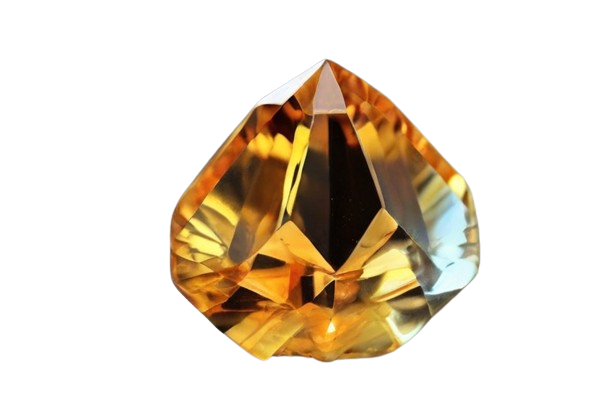
- Variety of Quartz:
- Citrine Gem is a variety of quartz, showcasing colors ranging from yellow to brownish-yellow.
- Composition:
- Composed of silicon and oxygen atoms, citrine belongs to the mineral quartz family.
- Popularity and Affordability:
- Among the most popular and affordable gemstones, citrine is favored in jewelry for its beauty and cost-effectiveness.
- Metaphysical Properties:
- Citrine is believed to possess unique metaphysical properties, with associations to promoting creativity, wealth, and abundance.
- Natural Occurrence:
- Natural citrine gem is relatively rare and is typically found in countries such as Brazil, Madagascar, and Zambia.
- Treatment and Color Change:
- In the market, a significant portion of citrine is heat-treated amethyst or smoky quartz, resulting in a color change to yellow or brownish-yellow.
- Historical Use in Jewelry:
- Citrine gem has a long history of being used in jewelry and as a decorative gemstone, appreciated for its aesthetic appeal.
- Cultural and Spiritual Associations:
- Ancient Greeks and Romans associated citrine with symbols of prosperity and happiness, adding cultural and spiritual significance to the gemstone.
Meaning:
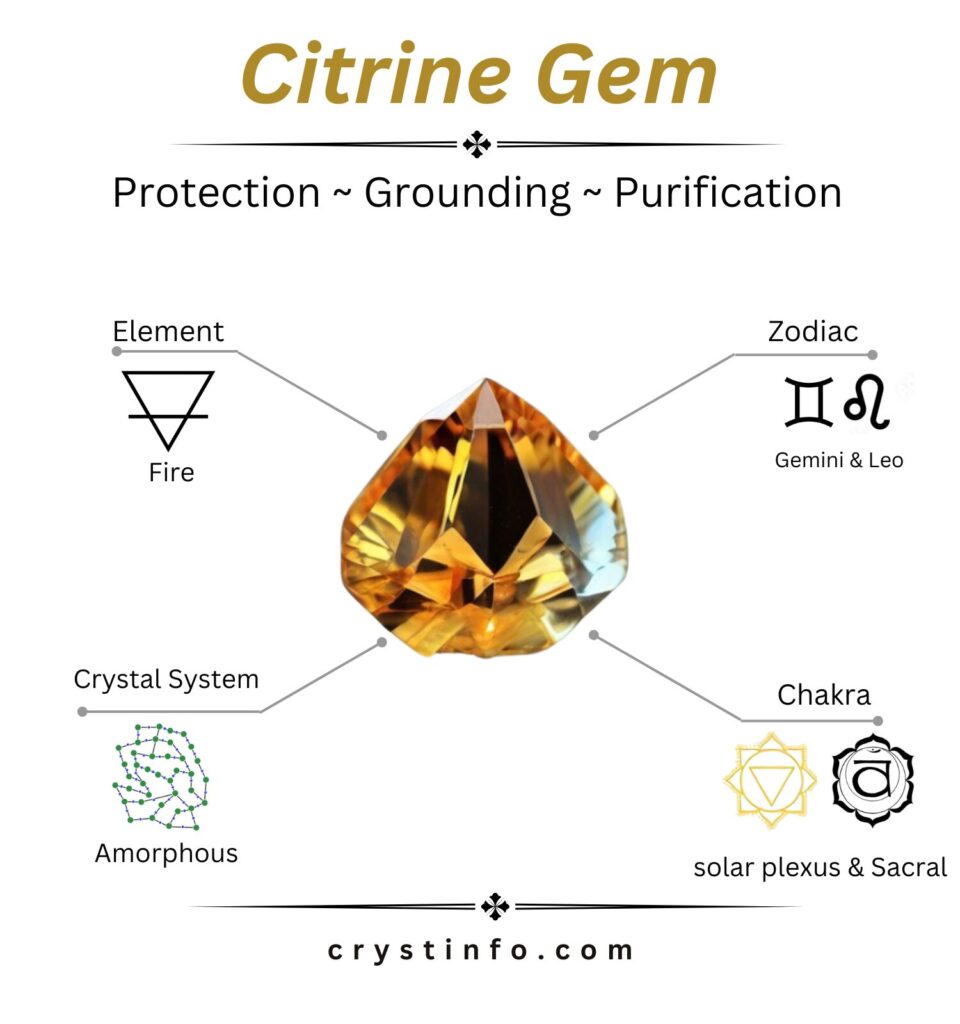
- Rarity and Gem Confusion:
- Citrine, a variety of quartz, is characterized by its transparent, pale yellow to brownish orange hues.
- In historical contexts, its tawny color often led to confusion with topaz due to similarities, especially before modern gemological practices were established.
- Top-Selling Yellow Gem:
- Citrine’s alluring color, coupled with its durability and affordability typical of quartz, positions it as the leading yellow-to-orange gem in the market.
- It serves as an attractive alternative not only to topaz but also to yellow sapphire.
- Color Characteristics:
- The finest citrine exhibits a saturated yellow to reddish-orange hue, devoid of brownish tints.
- This color richness contributes to the gem’s desirability and appeal.
- Treatment and Market Availability:
- Natural citrine is rare, and the majority in the market undergoes heat treatment.
- Heat treatment transforms some amethyst, changing its color from a pale violet to an attractive yellow.
- The resulting citrine’s yellow color is influenced by the original hue of the amethyst.
- Size Range and Availability:
- Citrine crystals come in a diverse range of sizes, with specimens up to 20 carats readily available for use in jewelry.
- While standard shapes and sizes exist, high-end designers and gem carvers often create unique cuts and carvings, adding artistic value to citrine jewelry.
- Jewelry Usage and Design Innovation:
- Citrine is a popular choice for jewelry, and its warm yellow tones complement various styles.
- High-end jewelry designers and gem carvers frequently explore innovative and unusual cuts, enhancing the aesthetic appeal of citrine pieces.
Citrine’s popularity is driven by its vibrant color, affordability, and versatility in jewelry design. While natural citrine is scarce, heat-treated variations ensure a consistent supply of this attractive gemstone, making it a preferred choice for those seeking warm yellow to reddish-orange hues.
| Property | Description |
|---|---|
| Name | Citrine |
| Composition | A variety of quartz, often colored by traces of iron. |
| Color | Yellow to golden-brown, may range from pale to deep hues. |
| Luster | Vitreous |
| Transparency | Transparent to translucent |
| Hardness | 7 on the Mohs scale |
| Crystal System | Hexagonal |
| Fracture | Conchoidal |
| Cleavage | Absent |
| Specific Gravity | 2.65 |
| Streak | White |
| Occurrence | Found in various locations worldwide, often in association with amethyst and other quartz varieties. |
| Uses | – Gemstone Use: Cut and faceted for use in jewelry. |
| – Metaphysical Beliefs: Associated with abundance, prosperity, and positive energy. Often used for manifestation and intention-setting. | |
| – Decorative Use: Carvings, spheres, and clusters are popular for decorative purposes. | |
| Spiritual Beliefs | Citrine is believed to carry the energy of the sun, bringing warmth, joy, and positivity. It is also associated with the solar plexus chakra. |
| Care Tips | Citrine is generally durable, but it can fade in prolonged exposure to sunlight. Avoid exposing it to harsh chemicals and clean with a soft cloth. |
| Note | Some citrine on the market may be heat-treated amethyst or other quartz varieties, but natural citrine is also available. |
Hardness:
Gravity:
Citrine is a variety of quartz known for its warm yellow to golden-brown color. It is valued for its beauty and is often associated with positive energy, abundance, and prosperity. In addition to its use in jewelry, citrine is popular for its metaphysical properties and decorative purposes. It is important to note that while some citrine is naturally occurring, other specimens in the market may be heat-treated amethyst or other quartz varieties.
Healing Properties:
- Mood Uplifter:
- Citrine, with its yellow hues, has the power to shake off maudlin moods, bringing a kiss of sunshine to uplift spirits.
- Instantly introduces positive energy to the surroundings, creating a vibrant and optimistic atmosphere.
- Good Vibes and Grace:
- Known for bringing good vibes and grace, Citrine becomes a radiant presence at any table, influencing the ambiance positively.
- Its sunny energy contributes to a sense of well-being and grace in various aspects of life.
- Health and Wealth Impact:
- Citrine is believed to have an immediate effect on the health and wealth of the body, mind, and soul.
- Its energetic properties are thought to promote overall well-being and attract prosperity.
- Bright and Blessed Energy:
- Natural Citrine is renowned for its bright and blessed energy, signifying its purity and positive vibrations.
- The stone’s inability to hold onto bad energy is highlighted, emphasizing its role as a purifier and transmuter of negativity.
- Reliable in Tough Times:
- Citrine is described as a reliable companion during tough times, capable of taking challenges in hand.
- Its transmutational qualities mean it can convert difficult situations into something special and positive.
- Investment in Health, Heart, and Happiness:
- Considered a stunning investment for overall well-being, Citrine is associated with health, heart, and happiness.
- Its radiant energy is believed to contribute positively to emotional, mental, and spiritual aspects of life.
Citrine’s impact extends beyond its visual appeal, with its energetic qualities seen as a valuable investment in one’s holistic health, emotional state, and overall happiness. The stone’s ability to transform energy and promote positivity makes it a cherished companion in navigating life’s challenges.
Physical Healing Properties:
- Energizing Properties:
- Citrine is renowned for bringing energy to the physical body.
- Its presence is likened to standing in the gentle glow of sunlight, providing a warming effect and uplifting moods.
- Thyroid Support:
- Citrine is believed to have positive effects on the thyroid gland.
- It works to support and maintain the optimal functioning of the thyroid, contributing to overall well-being.
- Vitamin D-like Qualities:
- Described as the equivalent of Vitamin D in stone form, Citrine is associated with the benefits of sunlight exposure.
- Introducing Citrine into one’s life is believed to dispel sluggish vibes and serve as an instant pick-me-up.
- Balanced Energy Boost:
- Citrine serves as an energy giver without pushing individuals into overdrive.
- It provides a balanced boost, uplifting the spirit without causing an imbalance.
- Remedy for Chronic Fatigue:
- Citrine is considered an amazing gift for those dealing with chronic fatigue.
- Its energizing properties make it a valuable companion for individuals facing conditions that deplete personal resources.
- Supports Digestive System:
- Citrine is associated with stimulating a healthy digestive system.
- Its presence is believed to contribute to better digestion, promoting overall digestive well-being.
- Enhances Blood Circulation:
- The use of Citrine is linked to improved blood circulation.
- It supports the circulatory system, enhancing the flow of blood throughout the body.
- Alleviates Allergies and Skin Irritations:
- Citrine is believed to have a calming effect on allergies and various skin irritations.
- Its energy is thought to help keep allergic reactions and skin issues at bay.
- Menstrual Pain Relief:
- Those experiencing menstrual pain and irregular cycles may find relief in the healing vibes of Citrine.
- It is suggested as a supportive remedy for menstrual discomfort.
- Remedy for Nausea:
- Citrine is considered a remedy against nausea.
- Its presence is believed to provide soothing effects for individuals dealing with nausea-related concerns.
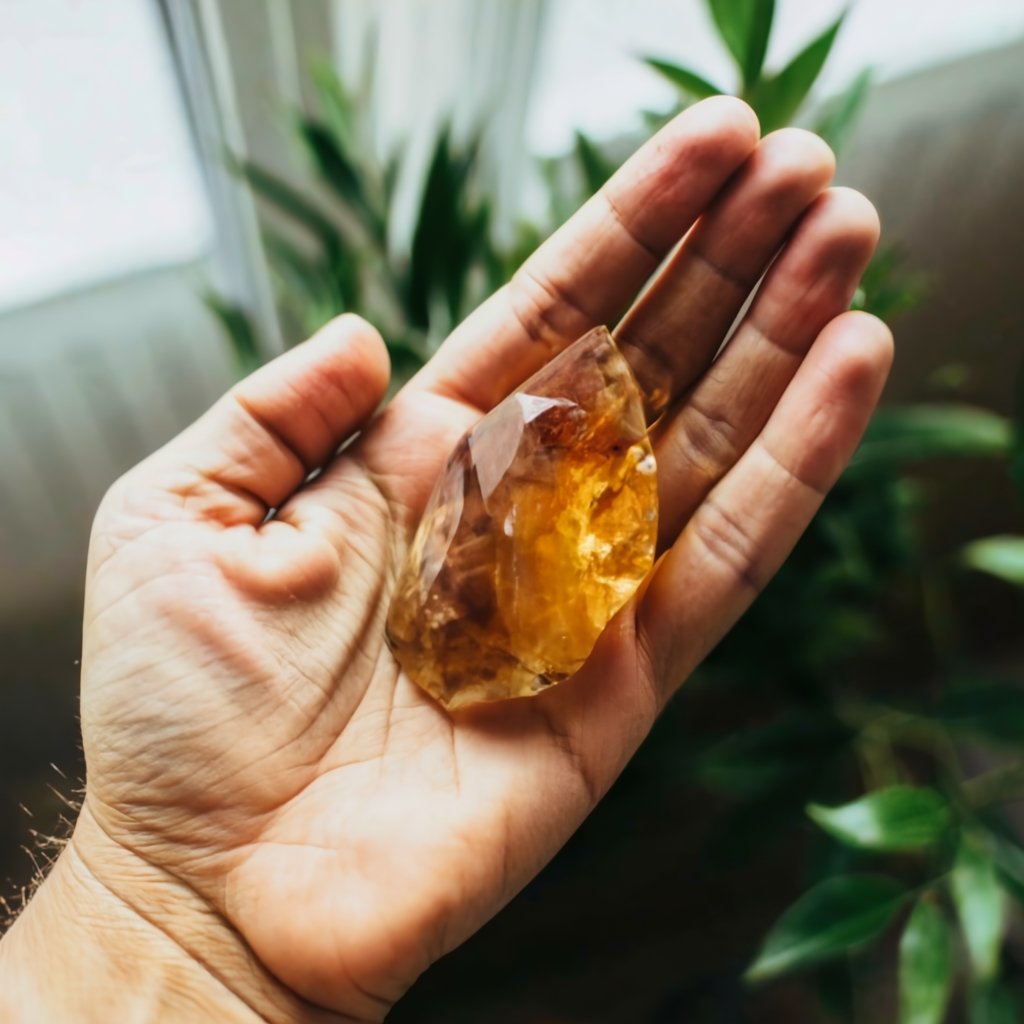
Citrine’s physical healing properties encompass a wide range of benefits, from providing a balanced energy boost to supporting specific bodily functions such as the thyroid, digestion, blood circulation, and more. Its gentle yet effective impact on various aspects of physical well-being makes it a sought-after crystal for holistic health.
Mental & Emotional Healing Properties:
| Properties of Citrine | |
|---|---|
| Release of Anger and Tension | Citrine facilitates the release of anger and tension, promoting a bright and sunny mood. It encourages individuals to let go of negativity, embrace optimism, and overcome feelings of confusion and depression. |
| Boosts Self-Esteem and Confidence | The crystal helps boost self-esteem and confidence, empowering individuals to reclaim their personal power with a smile. Citrine encourages a positive mindset, self-worth, and the ability to attract positive influences into one’s life. |
| Fighting Phobias and Enhancing Safety | Citrine assists in fighting phobias by channeling healing energy, instilling a sense of accountability for personal safety. It fosters an optimistic outlook and resilience, reminding individuals that they have the strength to overcome challenges. |
| Manifestation Powers and Optimism | Connected with manifestation, Citrine enhances the belief that anything is possible. It radiates a glow of creative energy, kickstarting the creative heart. With Citrine, individuals feel a surge of optimism, allowing them to attract positive experiences and opportunities. |
| Acceptance of Criticism with Grace | The crystal promotes a steady and graceful acceptance of criticism. It helps individuals stay resilient and open-minded in the face of feedback, fostering personal growth. |
| Attraction of Positive Relationships and Mentors | Citrine’s positive energy attracts good friends, healthy relationships, and inspirational mentors. It creates a magnetic effect, drawing positive individuals into one’s life. |
Chemical properties:
- Chemical Composition:
- Citrine shares an identical chemical composition with other quartz varieties, adhering to the chemical formula SiO2 (silicon dioxide).
- The unique yellow to brownish-yellow coloration of citrine results from trace amounts of iron impurities embedded within the crystal lattice.
- Iron Impurities and Color Variation:
- The presence of iron impurities in varying amounts influences the color saturation and intensity of citrine.
- The spectrum of yellows and browns observed in citrine is a result of the diverse concentrations of these iron impurities.
- Chemical Reactivity:
- Citrine exhibits relative inertness in terms of chemical reactivity.
- It does not react significantly with common acids or chemicals, emphasizing its stability in various environments.
- Exception: Hydrofluoric Acid Etching:
- Citrine is susceptible to etching by hydrofluoric acid.
- Hydrofluoric acid is a highly corrosive and dangerous chemical, making it crucial to handle citrine with care and avoid exposure to strong acids.
- Heat Resistance:
- Citrine displays resistance to heat, enduring temperatures ranging from 400-450 degrees Celsius.
- This thermal stability makes citrine suitable for applications involving elevated temperatures, such as in furnace tubes and laboratory equipment.
- Similarity to Quartz Varieties:
- While citrine possesses distinctive coloration due to iron impurities, its chemical properties align with those of other quartz varieties.
- The shared SiO2 composition underscores the fundamental similarity with quartz, with added elements influencing its appearance.
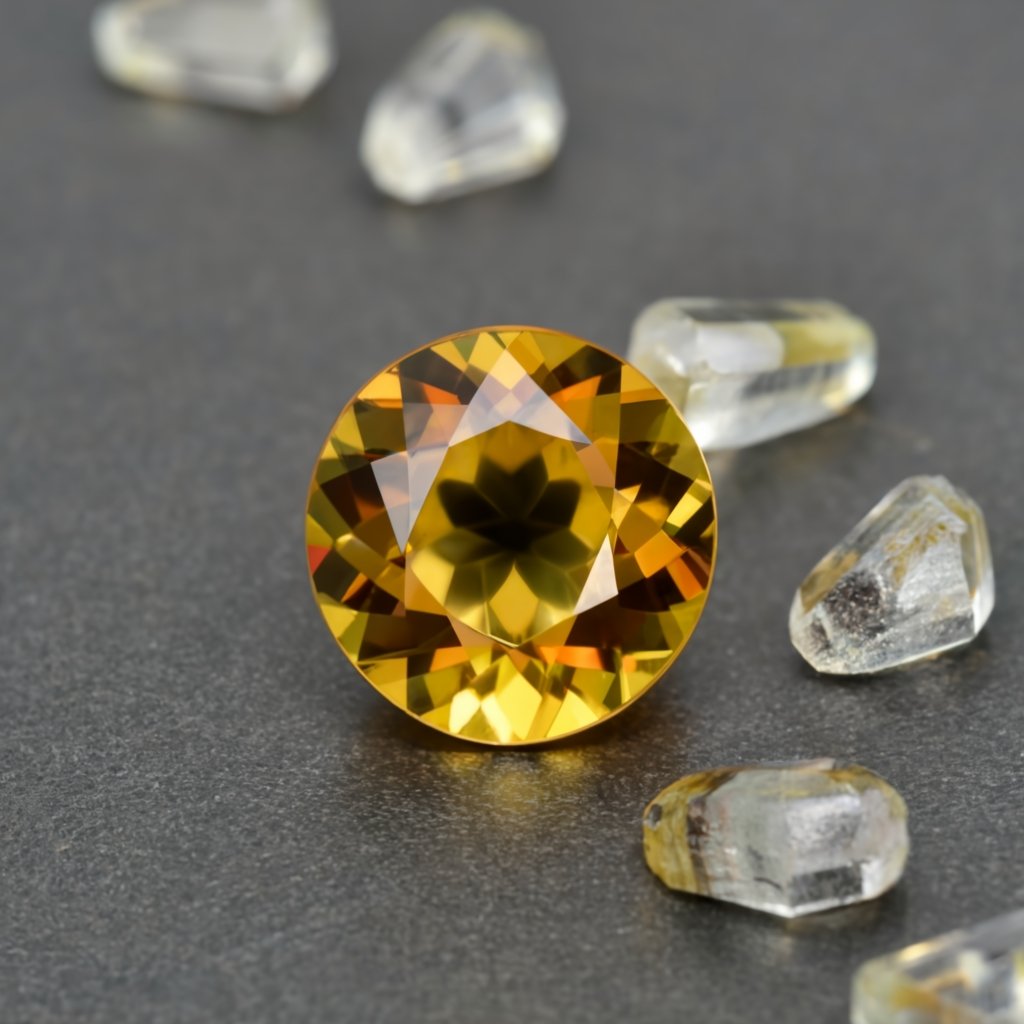
Citrine’s chemical properties, rooted in the SiO2 composition of quartz, reveal its stability in most environments. However, awareness of its vulnerability to hydrofluoric acid and its thermal resistance enhances understanding of its limitations and potential applications.
Comparison of natural and synthetic citrine:
| Aspect | Natural Citrine | Synthetic Citrine |
|---|---|---|
| Color | Varied yellow and brown hues with variations in saturation | More uniform and artificial-looking yellow color |
| Inclusions | May contain some inclusions or imperfections | Usually free of inclusions |
| Price | Generally more expensive due to rarity and value | Typically less expensive, as it is lab-created |
| Origin | Mined from the Earth | Created in a laboratory |
Natural citrine, formed through the gradual heating of amethyst in the Earth’s crust, exhibits a diverse range of yellow and brown tones with potential inclusions. On the other hand, synthetic citrine, produced by heating colorless quartz in a laboratory, tends to have a more uniform yellow color and is usually free of inclusions. Due to its rarity and natural formation, natural citrine is generally more expensive than its lab-created counterpart.
Occurrence of citrine in different rock types:
| Rock Type | Occurrence of Citrine |
|---|---|
| Granite | Often found in granite, forming in veins or cavities, or present as inclusions or coatings on other minerals. |
| Pegmatite | Commonly found in pegmatites, which are slow-cooling igneous rocks known for large crystal sizes and complex mineral compositions. |
| Gneiss | Found in gneiss, a metamorphic rock resulting from the high-heat and pressure transformation of pre-existing rocks, where citrine may be present due to the recrystallization of quartz-rich sediments or rocks. |
| Schist | Present in schist, another metamorphic rock formed from the recrystallization of pre-existing rocks under high heat and pressure, where citrine may result from the metamorphism of quartz-rich rocks or sediments. |
| Hydrothermal Veins | Found in hydrothermal veins, mineral deposits forming from hot, mineral-rich fluids circulating through fractures and faults in the earth’s crust. These veins may be associated with various rock types, including igneous, metamorphic, and sedimentary rocks. |
Chakras:
- Citrine is specifically connected to the Solar Plexus Chakra and the Sacral Chakra.
- These chakras, located either in the center or lower part of the body, play a crucial role in grounding and empowering individuals.
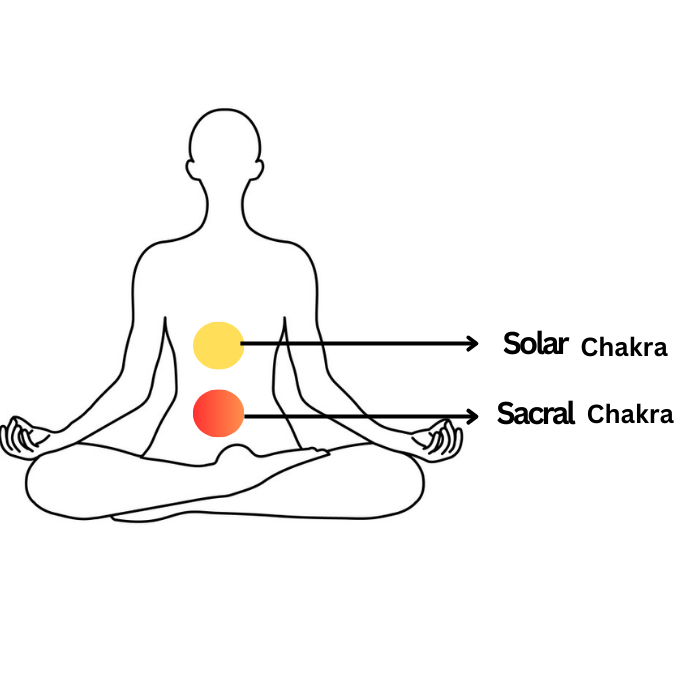
- Citrine influences the Solar Plexus Chakra, situated in the center of the body.
- This chakra is associated with warrior strength, personal power, and confidence.
- A blocked Solar Plexus Chakra can lead to feelings of instability, lack of centeredness, and challenges in setting boundaries.
- Citrine is also linked to the Sacral Chakra, located close to the pubic bone.
- The Sacral Chakra is associated with passion, creativity, intimacy, and joy.
- A blocked Sacral Chakra may result in feelings of overwhelm, a sense of loss of control, and emotional detachment.
Zodiac Birthstone:
| Citrine Attributes | |
|---|---|
| Zodiac Signs | Aries, Leo, Libra |
| Aries | Boosts confidence, provides stability, channels competitive energy positively. |
| Leo | Enhances positive energy, stimulates creativity, encourages optimism. |
| Libra | Aligns with intuitive power, fosters inner strength, aids decision-making. |
| Birthstone for November | Represents the winter month, provides light during darker days. |
Uses:
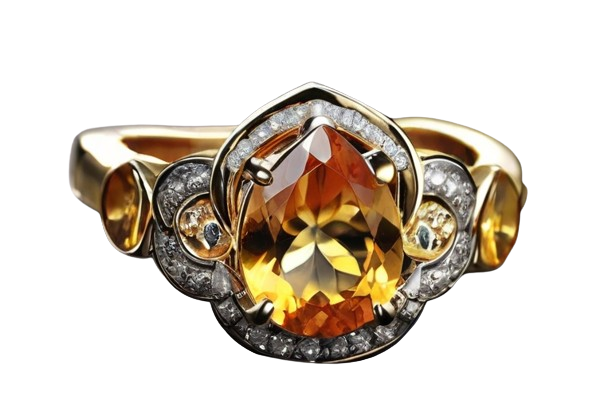
| Citrine Uses | description |
|---|---|
| Jewelry | Widely used in rings, necklaces, bracelets, and earrings for its warm, golden color. |
| Decorative Objects | Used in vases, sculptures, and figurines for its bright, sunny color, often in combination with other gemstones and materials. |
| Healing and Spiritual Practices | Employed in healing and spiritual practices to promote clarity of thought, enhance creativity, and boost energy levels. |
| Industrial Applications | Used as a heat-resistant material in furnace linings and high-temperature applications. Also utilized as a source of silicon in solar panel production. |
Origin:
- Brazil: Largest producer of citrine, particularly in the state of Rio Grande do Sul.
- Madagascar: Known for large, high-quality citrine crystals in various colors, found in regions like Antananarivo Province and Ilakaka.
- Russia: Produces citrine, often pale yellow or smoky brown, with deposits in the Ural Mountains and other regions.
- Spain: Citrine deposits found in the Catalonia region.
- Zambia: Citrine deposits are located in the Luapula Province.
- United States: Citrine found in various locations including Colorado, North Carolina, and California.
Citrine is widespread globally, with variations in quality and characteristics based on geological factors and regions of origin.
How To Clean?
| Cleaning Method | Procedure |
|---|---|
| Running Water | Hold the citrine under running water for a solid minute, then towel dry. Ensure water temperature is at room temperature to prevent potential damage. |
| Meditation Cleansing | Meditate over the citrine, setting the intention for cleansing with your mind’s eye. |
| Moonlight Exposure | Place the citrine under the light of the full moon and leave it overnight. Moonlight exposure is believed to cleanse and recharge the gemstone. |
| Saltwater Submersion | Make a saltwater solution and submerge the citrine in it for up to 24 hours. Ensure the stone is compatible with water and won’t be damaged. |
| Ground Burying | Bury the citrine in the garden and leave it there for up to 48 hours. Ensure the soil is loose enough for easy retrieval and that it won’t harm the gemstone. |
| Rainwater Cleansing | In the event of a rainstorm, place the citrine under the showers to let the rainwater cleanse it. Ensure the gemstone is safe in water. |
| Incense or Herb Smoke | Burn incense or herbs over the citrine to cleanse and recharge it. Ensure the smoke does not negatively affect the gemstone. |
| Selenite Cleansing | Place the citrine on a selenite slab for at least 6 hours. Selenite is believed to clear and recharge crystals by removing unwanted energy. |
| Soil Burial | Bury the citrine in the soil for a day or two to ground and neutralize any negative energy stored in the crystal. Ensure the soil won’t harm the gemstone. |
| Sunlight Exposure | Expose the citrine under direct sunlight for a few hours. Sunlight is thought to penetrate the crystal and clear any negative energy trapped inside. Ensure the gemstone is safe in sunlight. |
Conclusion:
Citrine is a radiant gemstone celebrated for its warm, golden tones and reputed metaphysical properties. From symbolizing abundance to enhancing creativity, this gem combines beauty with positive energy, making it a popular choice in both jewelry and holistic practices. Whether worn for aesthetics or believed benefits, citrine remains a timeless and versatile gemstone, bringing a touch of sunshine to those who embrace its charm.
FAQs:
- What is Citrine?
- Citrine is a vibrant gemstone characterized by its warm, golden hues. It belongs to the quartz family and is often associated with positive energy.
- What are the properties of Citrine?
- Citrine is known for its energetic and uplifting properties. It is believed to symbolize abundance, promote clarity, and enhance creativity. The gemstone is also valued for its warm and inviting color.
- How is Citrine used in jewelry?
- Citrine is a popular choice for jewelry, including rings, necklaces, and earrings. Its golden color adds a touch of warmth and elegance to various designs.
- What metaphysical benefits are associated with Citrine?
- Citrine is thought to bring prosperity, success, and positive energy. Many believe it can help clear the mind, stimulate creativity, and foster a sense of abundance.
- Can Citrine be used for meditation or holistic practices?
- Yes, citrine is often used in meditation and holistic practices to harness its alleged metaphysical properties. Some people use it to enhance focus, increase self-esteem, and attract positive energy.
- Is Citrine a birthstone, and what does it symbolize?
- Citrine is not a traditional birthstone, but it is sometimes associated with the month of November. It is often seen as a symbol of joy, warmth, and success.
- How should Citrine be cared for?
- Citrine is generally durable but should be handled with care to avoid scratches. It is best cleaned with warm, soapy water and a soft brush. Avoid exposing it to prolonged sunlight to prevent color fading.


![Ocean Jasper: Explore Spiritual Healing and Energies [Guide]](https://crystinfo.com/wp-content/uploads/2023/12/Add-a-heading-16-768x402.jpg)
![[Zodiac Signs]: Unraveling the Mysteries Behind Astrological Signs](https://crystinfo.com/wp-content/uploads/2024/02/Spirit-Quartz-3-768x402.jpg)
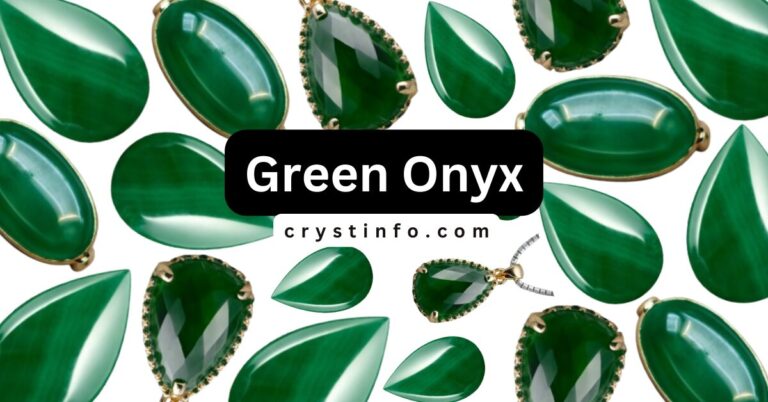
![Peach Moonstone: Nurturing Love, Clarity, and Spiritual[Guide]](https://crystinfo.com/wp-content/uploads/2024/01/Green-Jasper-1-768x402.jpg)
![Pink Opal Secrets: Meaning, Healing, and More [Guide]](https://crystinfo.com/wp-content/uploads/2024/01/Blue-Goldstone-9-768x402.jpg)
![Apache Tears: Unveiling Obsidian Power and [Emotional Transformation]](https://crystinfo.com/wp-content/uploads/2024/01/Chakras-4-768x402.jpg)